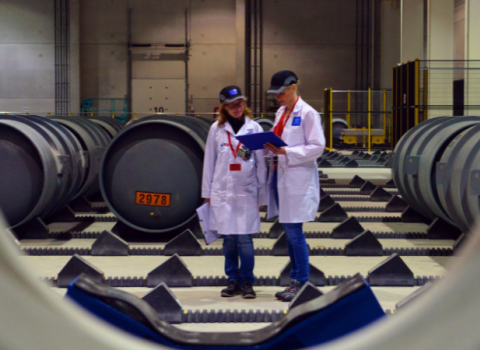MEPs believe investment in small modular reactors is needed for Europe to develop a sustainable low-carbon energy system

MEP Franc Bogovič during a Parliamentary committee meeting debate today on the creation of a new joint undertaking on small modular reactors. Photo: European Union
MEPs are pushing for action to promote the development and deployment of small-scale nuclear power stations which they say are an essential part of the mix in cutting carbon emissions and reaching net zero by 2050.
The Parliament industry, research and energy (ITRE) committee took up the cause in a debate today in which they called for the creation of a new joint undertaking on small modular reactors (SMRs).
As things stand, there are no commercial SMRs in operation, but the technology is currently under development in 18 countries. In 2021, US company NuScale Power struck an agreement with Romania’s Nuclearelectrica to build a next-generation nuclear power station comprised of six SMRs on the site of the former Doicesti coal plant.
SMRs are smaller than conventional nuclear reactors, with power outputs of between 10 and 300 MW. They are in theory easier to install, as their standardised design means they can be mass produced in a factory and assembled on site.
Potential uses include district heating, desalination, power for energy-intensive industries such as steel and cement manufacture and the production of green hydrogen.
“SMRs also have a potential to open new markets for supply of low carbon electricity, such as isolated or remote areas, and they are adapted to small and medium sized electricity grids,” says the draft report debated by ITRE.
The report also calls for R&D funding to include fourth-generation advanced modular reactors which will use novel fuels and coolants.
Five workstreams
The Commission organised the first EU workshop on SMRs in 2021, leading to a proposal for a European SMR partnership, involving industry, research and technology bodies and potential customers.
To lay the ground for this, five workstreams looked at the essentials for safe adoption of SMRs: market integration and deployment; licensing; financing and partnership; supply chain adaptation; and innovation, research and development. The conclusions are now open for comments until 15 September. Revised versions will be presented at a meeting in Brussels on 26 October.
In April, the Commission reiterated its commitment to supporting the development of SMRs and launching a €15 million project in Euratom to support the safety of European Light Water SMRs. The programme will also include €12 million co-funding for researchers and industry to work together on the safety of advanced modular reactors with interested member states.
The rapporteur, the EPP’s Franc Bogovič, said this preliminary work was necessary to lay the ground for agreeing common regulations on issues such as safety standards, but a joint undertaking would provide more concrete support for SMR development.
“Under Horizon, joint undertakings usually have around €1 billion in funding,” he told Science|Business, comparing this to US funding in the Inflation Reduction Acts which allows for tax credits for SMRs, and dedicates $700 million to the development of new forms of uranium for use in SMRs.
“It is important that we have something similar in Europe if we also want to make this development and not fall behind other parts of the world,” Bogovič said.
“I believe SMRs together with large nuclear power plants and renewables are the solution to transition to a low carbon society. SMRs solve many of the problems which don’t have good solutions, such as district heating, industry, and hydrogen production.”
Speaking at the ITRE debate, Robert Roos, shadow rapporteur, said SMRs should be part of the energy mix but are being held back because they are not covered by regulations relating to renewable energy. “Even when we have safe and cost-effective SMRs, governments will still be stuck with renewable energy regulations which exclude nuclear.”
The draft report also calls for the harmonisation of licensing regimes, which would be easier if designs were standardised.
Jan Panek, deputy director general responsible for nuclear energy, safety and ITER at the European Commission told ITRE, “reliable but streamlined licencing” is a pre-condition for the success of SMRs. “Licencing will have to stay a national decision, but given the characteristics of the technology, [member states] should be able to use data from each other,” he said.
The deadline for amendments on the draft report is 21 September, with the committee expected to vote on the text in December. Bogovič is hoping the report will go to plenary in early 2024, ahead of next year’s European elections.
The trade association Nucleareurope said an initiative is needed at EU level. The EU SMR Partnership could take the form of an industrial alliance, within which a joint undertaking could be implemented to answer specific needs. “The discussions with stakeholders in October will help decide the best way forward,” a spokesperson said.
Earlier this year, the first NuScale Energy Exploration centre outside the US was inaugurated at the Polytechnic University of Bucharest. The centre includes a simulator of an SMR power plant control room, for training nuclear engineers.
Czech utility company CEZ also plans to deploy an SMR near the Temelín nuclear power plant by 2032. CEZ has signed memoranda on cooperation with NuScale, GE Hitachi, Rolls-Royce, EDF, Korea Hydro & Nuclear Power and Holtec.
In 2021, nuclear energy made up 13.1% of the EU energy mix, with nuclear power stations in 12 member states.





 A unique international forum for public research organisations and companies to connect their external engagement with strategic interests around their R&D system.
A unique international forum for public research organisations and companies to connect their external engagement with strategic interests around their R&D system.